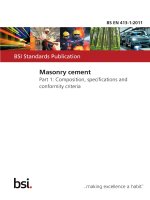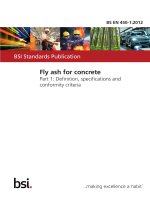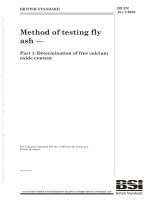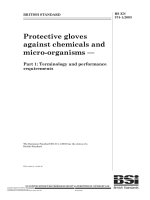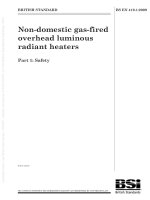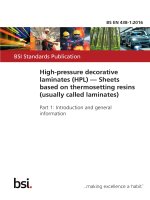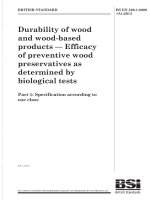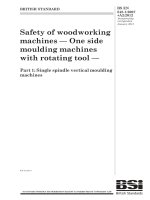Bsi bs en 62395 1 2013
Bạn đang xem bản rút gọn của tài liệu. Xem và tải ngay bản đầy đủ của tài liệu tại đây (1.94 MB, 48 trang )
BS EN 62395-1:2013
BSI Standards Publication
Electrical resistance trace
heating systems for
industrial and commercial
applications
Part 1: General and testing requirements
BRITISH STANDARD
BS EN 62395-1:2013
National foreword
This British Standard is the UK implementation of EN 62395-1:2013. It
is identical to IEC 62395-1:2013. It supersedes BS EN 62395-1:2006
which is withdrawn.
The UK participation in its preparation was entrusted to Technical
Committee PEL/27, Electroheating.
A list of organizations represented on this committee can be obtained on
request to its secretary.
This publication does not purport to include all the necessary provisions of
a contract. Users are responsible for its correct application.
© The British Standards Institution 2013.
Published by BSI Standards Limited 2013
ISBN 978 0 580 77527 7
ICS 25.180.10
Compliance with a British Standard cannot confer immunity from
legal obligations.
This British Standard was published under the authority of the
Standards Policy and Strategy Committee on 31 December 2013.
Amendments/corrigenda issued since publication
Date
Text affected
BS EN 62395-1:2013
EN 62395-1
EUROPEAN STANDARD
NORME EUROPÉENNE
EUROPÄISCHE NORM
December 2013
ICS 25.180.10
Supersedes EN 62395-1:2006
English version
Electrical resistance trace heating systems for industrial
and commercial applications Part 1: General and testing requirements
(IEC 62395-1:2013)
Systốmes de traỗage par résistance
électrique pour applications industrielles
et commerciales Partie 1: Exigences générales et d'essai
(CEI 62395-1:2013)
Elektrische Widerstands-Begleitheizungen
für industrielle und gewerbliche Zwecke Teil 1: Allgemeine Anforderungen und
Prüfanforderungen
(IEC 62395-1:2013)
This European Standard was approved by CENELEC on 2013-10-14. CENELEC members are bound to comply
with the CEN/CENELEC Internal Regulations which stipulate the conditions for giving this European Standard
the status of a national standard without any alteration.
Up-to-date lists and bibliographical references concerning such national standards may be obtained on
application to the CEN-CENELEC Management Centre or to any CENELEC member.
This European Standard exists in three official versions (English, French, German). A version in any other
language made by translation under the responsibility of a CENELEC member into its own language and notified
to the CEN-CENELEC Management Centre has the same status as the official versions.
CENELEC members are the national electrotechnical committees of Austria, Belgium, Bulgaria, Croatia, Cyprus,
the Czech Republic, Denmark, Estonia, Finland, Former Yugoslav Republic of Macedonia, France, Germany,
Greece, Hungary, Iceland, Ireland, Italy, Latvia, Lithuania, Luxembourg, Malta, the Netherlands, Norway, Poland,
Portugal, Romania, Slovakia, Slovenia, Spain, Sweden, Switzerland, Turkey and the United Kingdom.
CENELEC
European Committee for Electrotechnical Standardization
Comité Européen de Normalisation Electrotechnique
Europäisches Komitee für Elektrotechnische Normung
CEN-CENELEC Management Centre: Avenue Marnix 17, B - 1000 Brussels
© 2013 CENELEC -
All rights of exploitation in any form and by any means reserved worldwide for CENELEC members.
Ref. No. EN 62395-1:2013 E
BS EN 62395-1:2013
EN 62395-1:2013
-2-
Foreword
The text of document 27/926/FDIS, future edition 2 of IEC 62395-1, prepared by IEC/TC 27 "Industrial
electroheating and electromagnetic processing" was submitted to the IEC-CENELEC parallel vote and
approved by CENELEC as EN 62395-1:2013.
The following dates are fixed:
•
latest date by which the document has to be
implemented at national level by
publication of an identical national
standard or by endorsement
(dop)
2014-07-14
•
latest date by which the national
standards conflicting with the
document have to be withdrawn
(dow)
2016-10-14
This document supersedes EN 62395-1:2006.
EN 62395-1:2013 includes
EN 62395-1:2006:
the
following
significant
technical
changes
with
respect
to
-
tests have been added for trace heating on sprinkler systems;
-
the flammability test has
1)
IEC/IEEE 60079-30-1 ;
-
a supplementary test has been added for the verification of sheath temperature using trace heating
mounted on a plate fixture.
been
changed
to
align
with
the
latest
draft
of
future
Attention is drawn to the possibility that some of the elements of this document may be the subject of
patent rights. CENELEC [and/or CEN] shall not be held responsible for identifying any or all such
patent rights.
This standard covers the Principle Elements of the Safety Objectives for Electrical Equipment
Designed for Use within Certain Voltage Limits (LVD - 2006/95/EC).
Endorsement notice
The text of the International Standard IEC 62395-1:2013 was approved by CENELEC as a European
Standard without any modification.
1)
Under consideration.
BS EN 62395-1:2013
EN 62395-1:2013
-3-
Annex ZA
(normative)
Normative references to international publications
with their corresponding European publications
The following documents, in whole or in part, are normatively referenced in this document and are
indispensable for its application. For dated references, only the edition cited applies. For undated
references, the latest edition of the referenced document (including any amendments) applies.
NOTE When an international publication has been modified by common modifications, indicated by (mod), the relevant EN/HD
applies.
Publication
Year
Title
EN/HD
Year
IEC 60068-2-5
-
Environmental testing Part 2-5: Tests - Test Sa: Simulated solar
radiation at ground level and guidance for
solar radiation testing
EN 60068-2-5
-
IEC 60519-1
-
Safety in electroheating installations Part 1: General requirements
EN 60519-1
-
IEC 60519-10
-
Safety in electroheating installations EN 60519-10
Part 10: Particular requirements for electrical
resistance trace heating systems for
industrial and commercial applications
-
IEC 62395-2
2013
Electrical resistance trace heating systems EN 62395-2
for industrial and commercial applications Part 2: Application guide for system design,
installation and maintenance
2013
ASTM D 5025-05
-
Standard Specification for Laboratory Burner
Used for Small-Scale Burning Tests on
Plastic Materials
ASTM D 5207-09
-
Standard Practice for Confirmation of 20-mm
(50-W) and 125-mm (500-W) Test Flames
for Small-Scale Burning Tests on Plastic
Materials
–2–
BS EN 62395-1:2013
62395-1 © IEC:2013
CONTENTS
INTRODUCTION ..................................................................................................................... 6
1
Scope ............................................................................................................................... 7
2
Normative references ....................................................................................................... 8
3
Terms and definitions ....................................................................................................... 8
4
General requirements ..................................................................................................... 13
4.1
4.2
4.3
4.4
5
General ................................................................................................................. 13
Electrically conductive covering ............................................................................. 13
Electrical circuit protection requirements for branch circuits .................................. 13
Temperature requirements .................................................................................... 14
4.4.1 General ..................................................................................................... 14
4.4.2 Stabilized design ....................................................................................... 14
4.4.3 Controlled design ...................................................................................... 14
Testing ........................................................................................................................... 14
5.1
5.2
5.3
5.4
Type tests – General ............................................................................................. 14
Type tests – All applications .................................................................................. 14
5.2.1 Dielectric test ............................................................................................ 14
5.2.2 Electrical insulation resistance test ............................................................ 15
5.2.3 Flammability test ....................................................................................... 16
5.2.4 Room temperature impact test ................................................................... 17
5.2.5 Minimum temperature impact test .............................................................. 19
5.2.6 Deformation test ........................................................................................ 20
5.2.7 Cold bend test ........................................................................................... 21
5.2.8 Water resistance test ................................................................................. 22
5.2.9 Integral components resistance to water test ............................................. 22
5.2.10 Verification of rated output ......................................................................... 23
5.2.11 Thermal stability of electrical insulating material ........................................ 25
5.2.12 Thermal performance test for parallel trace heaters ................................... 26
5.2.13 Determination of maximum sheath temperature ......................................... 27
5.2.14 Verification of start-up current ................................................................... 34
5.2.15 Verification of the electrical resistance of the electrically conductive
covering .................................................................................................... 34
5.2.16 Strain relief test for connections (terminations) .......................................... 34
Type tests – Additional tests for outdoor exposed surface heating
installations without thermal insulation .................................................................. 35
5.3.1 Verification of rated output ......................................................................... 35
5.3.2 Determination of maximum sheath temperature ......................................... 35
5.3.3 Increased moisture resistance test ............................................................ 35
5.3.4 UV test ...................................................................................................... 35
5.3.5 Resistance to cutting test .......................................................................... 35
5.3.6 Abrasion test ............................................................................................. 35
5.3.7 Tension test ............................................................................................... 36
5.3.8 Rail system voltage spike test ................................................................... 36
5.3.9 Rail system over-voltage test ..................................................................... 37
Type tests – Additional tests and test modifications for embedded heating
applications ........................................................................................................... 37
5.4.1 Verification of rated output ......................................................................... 37
BS EN 62395-1:2013
62395-1 © IEC:2013
–3–
6
5.4.2 Determination of maximum sheath temperature ......................................... 37
5.4.3 Resistance to cutting test .......................................................................... 37
5.4.4 Flammability test ....................................................................................... 37
5.5 Type tests – Additional tests for applications of trace heating internal to
conduit and piping ................................................................................................. 37
5.5.1 Verification of rated output ......................................................................... 37
5.5.2 Determination of maximum sheath temperature ......................................... 37
5.5.3 Increased moisture resistance test ............................................................ 37
5.5.4 Pull-strength test ....................................................................................... 38
5.6 Type tests – Additional requirements for sprinkler systems .................................... 38
5.6.1 Normal and abnormal operation test .......................................................... 38
5.6.2 Normal operation test ................................................................................ 38
5.6.3 Abnormal operation test ............................................................................. 41
5.7 Routine tests ......................................................................................................... 41
5.7.1 Dielectric test ............................................................................................ 41
5.7.2 Verification of rated output ......................................................................... 41
Marking .......................................................................................................................... 41
7
6.1 General ................................................................................................................. 41
6.2 Product markings .................................................................................................. 42
Installation instructions ................................................................................................... 42
Bibliography .......................................................................................................................... 44
Figure 1 – Flammability test .................................................................................................. 17
Figure 2 – Room temperature impact test ............................................................................. 18
Figure 3 – Example of room temperature impact test apparatus ............................................ 19
Figure 4 – Example of minimum temperature impact test apparatus ...................................... 20
Figure 5 – Cold bend test ...................................................................................................... 22
Figure 6 – Moisture resistance test ....................................................................................... 23
Figure 7 – Verification of rated output ................................................................................... 25
Figure 8 – Pipe fixture........................................................................................................... 29
Figure 9 – Plate fixture.......................................................................................................... 30
Figure 10 – Plate fixture when trace heaters are allowed to touch ......................................... 31
Figure 11 – Maximum sheath temperature using the product approach ................................. 34
Figure 12 – Abrasion test ...................................................................................................... 36
Figure 13 – Sprinkler system temperature control test – branch line arrangement ................. 39
Figure 14 – Sprinkler system temperature control test – branch line – alternative
arrangement ......................................................................................................................... 40
Figure 15 – Sprinkler system temperature control test – supply pipe arrangement ................ 40
Table 1 – Test voltages for the dielectric test ........................................................................ 15
Table 2 – Product marking .................................................................................................... 42
–6–
BS EN 62395-1:2013
62395-1 © IEC:2013
INTRODUCTION
IEC 62395-1 provides the essential requirements and testing appropriate to electrical
resistance trace heating equipment used in industrial and commercial applications. While
some of this work already exists in national or international standards, this standard has
collated much of this existing work and added considerably to it.
IEC 62395-2 provides detailed recommendations for the system design, installation and
maintenance of electric trace heating systems in industrial and commercial applications.
It is the objective of IEC 62395 that, when in normal use, electrical trace heating systems
operate safely under their defined conditions of use, by
a) employing heaters of the appropriate construction and meeting the test criteria detailed in
IEC 62395-1. The construction includes a metallic sheath, braid, screen or equivalent
electrically conductive covering;
b) operating at safe temperatures when designed, installed, and maintained in accordance
with IEC 62395-2.
c) having at least the minimum levels of overcurrent and earth-fault protection required in
IEC 62395-1 and IEC 62395-2.
BS EN 62395-1:2013
62395-1 © IEC:2013
–7–
ELECTRICAL RESISTANCE TRACE HEATING SYSTEMS
FOR INDUSTRIAL AND COMMERCIAL APPLICATIONS –
Part 1: General and testing requirements
1
Scope
This part of IEC 62395 specifies requirements for electrical resistance trace heating systems
and includes general test requirements.
This standard pertains to trace heating systems that may comprise either factory-fabricated or
field-assembled (work-site) units, and which may be series and parallel trace heaters or
surface heaters (heater pads and heater panels) that have been assembled and/or terminated
in accordance with the manufacturer’s instructions.
This standard also includes requirements for termination assemblies and control methods
used with trace heating systems.
This standard provides the essential requirements and testing appropriate to electrical
resistance trace heating equipment used in industrial and commercial applications. The
products certified according to this standard are intended to be installed by persons who are
suitably trained in the techniques required and that only trained personnel carry out especially
critical work, such as the installation of connections and terminations. Installations are
intended to be carried out under the supervision of a qualified person who has undergone
supplementary training in electric trace heating systems.
This standard does not include or provide for any applications in potentially explosive
atmospheres.
This standard does not cover induction, impedance or skin effect heating.
Trace heating systems can be grouped into different types of applications and the different
conditions found during and after installation necessitate different requirements for testing.
Trace heating systems are usually certified for a specific type of installation or application.
Typical applications for the different types of installation include, but are not limited to:
a) installations of trace heating for surface heating on pipes, vessels and associated
equipment – applications include:
–
freeze protection and temperature maintenance;
–
hot water lines;
–
oil and chemical lines;
–
sprinkler system mains and supply piping;
b) outdoor exposed area installations of trace heating – applications include:
–
roof de-icing;
–
gutter and down-spout de-icing;
–
catch basins and drains;
–
rail heating 2;
—————————
2 Further evaluation may be required to address application specific conditions such as fluctuations in impressed
voltage and voltage spikes.
–8–
BS EN 62395-1:2013
62395-1 © IEC:2013
c) installation with embedded trace heating – applications include:
–
snow melting;
–
frost heave protection;
–
floor warming;
–
energy storage systems;
–
door frames;
d) installations of trace heating internal to conduit and piping – applications include:
2
–
snow melting – in conduit;
–
frost heave protection – in conduit;
–
floor warming – in conduit;
–
energy storage systems – in conduit;
–
internal trace heating for freeze protection of potable water lines;
–
enclosed drains and culverts.
Normative references
The following documents, in whole or in part, are normatively referenced in this document and
are indispensable for its application. For dated references, only the edition cited applies. For
undated references, the latest edition of the referenced document (including any
amendments) applies.
IEC 60068-2-5, Environmental testing – Part 2-5: Tests – Test Sa: Simulated solar radiation at
ground level and guidance for solar radiation testing
IEC 60519-1, Safety in electroheating installations – Part 1: General requirements
IEC 60519-10, Safety in electroheating installations – Part 10: Particular requirements for
electrical resistance trace heating systems for industrial and commercial applications
IEC 62395-2:2013, Electrical resistance trace heating systems for industrial and commercial
applications – Part 2: Application guide for system design, installation and maintenance
ASTM D 5025-05, Standard Specification for Laboratory Burner Used for Small-Scale Burning
Tests on Plastic Materials
ASTM D 5207-09, Standard Practice for Confirmation of 20-mm (50-W) and 125-mm (500-W)
Test Flames for Small-Scale Burning Tests on Plastic Materials
3
Terms and definitions
For the purposes of this document, the terms and definitions given in IEC 60519-10 and the
following apply.
NOTE 1 General definitions are given in the International Electrotechnical Vocabulary, IEC 60050. Terms relating
to industrial electroheat are defined in IEC 60050-841.
NOTE 2
The terms defined in this clause are used both in IEC 62395-1 and IEC 62395-2.
3.1
ambient temperature
temperature surrounding the object under consideration
BS EN 62395-1:2013
62395-1 © IEC:2013
–9–
Note 1 to entry: Where trace heaters or surface heaters are enclosed in thermal insulation, the ambient
temperature is the temperature exterior to such thermal insulation.
3.1.1
maximum ambient temperature
the highest specified ambient temperature
3.1.2
minimum ambient temperature
the lowest specified ambient temperature
Note 1 to entry:
Heat-loss calculations in IEC 62395-2 are based on the minimum ambient temperature.
3.2
branch circuit
portion of the wiring installation between the overcurrent device protecting the circuit and the
trace heater(s) or surface heater(s)
3.3
cold lead
electrically insulated conductor or conductors used to connect a trace heater or surface
heater to the branch circuit and designed so that it does not produce significant heat
3.4
connection
termination or splice used to attach trace heaters or surface heaters to power wiring or to
connect sections of these devices
3.5
dead leg
segment of process piping segregated from the normal flow pattern for the purpose of
providing a heat loss reference
3.6
design loading
minimum power that will meet the design requirements, in the worst conditions, after voltage
and resistance tolerances and appropriate safety factors have been considered
3.7
electrically conductive covering
metallic sheath, metallic braid, or electrically conductive material
3.8
end termination
termination, which may be heat producing, applied to a trace heater at the end opposite to
that where the power is supplied
[SOURCE: IEC 60050-426:2008, 426-20-04]
3.9
factory-fabricated unit
trace heater unit or set or surface heater unit or set, including the necessary terminations and
connections, assembled by the manufacturer
3.10
field-assembled unit
trace heaters or surface heaters supplied unterminated with terminating components to be
assembled at the work site
– 10 –
BS EN 62395-1:2013
62395-1 © IEC:2013
3.11
heat loss
energy flow from a pipe, vessel or equipment to its surroundings
3.12
heat sink
part that conducts and dissipates heat away from a workpiece
Note 1 to entry: Typical heat sinks are pipe shoes, pipe supports and items of large mass such as valve actuators
or pump bodies.
3.13
heat transfer aids
thermally conductive materials, such as metallic foils or heat transfer compounds used to
increase the heat-transfer efficiency from trace heaters or surface heaters to the workpiece
3.14
heater pad
surface heater, comprising series or parallel connected elements having sufficient flexibility to
conform to the shape of the surface to be heated
3.15
heater panel
non-flexible surface heater, comprising series or parallel connected elements fabricated to
conform to the general shape of the surface to be heated
3.16
high limit temperature
maximum allowable temperature of the system, including piping, fluid and trace heating
system
3.17
integral component
component such as a heat shrink termination, a cold lead connection, a moulded end seal or
a splice, which conforms to the general shape of the trace heater or surface heater and is
exposed to the same environment as the trace heater or surface heater, which may be
factory-fabricated or field-assembled, and which is not intended to be re-used in the event of
a repair or modification
3.18
low risk of mechanical damage
installations and applications where only lower levels of impact and deformation are expected
to occur
3.19
maximum sheath temperature
maximum temperature of the outermost continuous covering of the trace heater or surface
heater
3.20
maximum withstand temperature
maximum operating or exposure temperature that does not adversely affect the thermal
stability of the trace heater or surface heater and its component parts
3.21
operating voltage
actual voltage applied to the trace heater or surface heater when in service
BS EN 62395-1:2013
62395-1 © IEC:2013
– 11 –
3.22
overjacket
continuous layer of material applied outside the electrically conductive covering to protect
against corrosion
3.23
parallel trace heater
heating elements electrically connected in parallel, with the heating element either continuous
or in discrete units or zones, such that the watt density per unit length is not significantly
changed with any change in circuit length
3.24
power density
power output in watts per linear metre for trace heaters, and in watts per square metre for
surface heaters
3.25
power termination
termination applied to the end of a trace heater or surface heater at which the power is
supplied
3.26
rated output
total power or power per unit length or unit surface area of the trace heater or surface heater,
at rated voltage and temperature, which is normally expressed in watts, watts per metre or
watts per square metre
3.27
rated voltage
voltage assigned by the manufacturer to which operating and performance characteristics of
trace heaters or surface heaters are referred
3.28
routine test
test to which each individual device is subjected during or after manufacture to ascertain
whether it complies with certain criteria
3.29
series trace heater
heating elements electrically connected in series with a single current path and with a specific
resistance at a given temperature for a given length
3.30
sheath
uniform and continuous covering(s), metallic or non-metallic, enclosing the insulated
conductor(s), used to protect the trace heater or surface heater against mechanical damage
and influences from the surroundings (corrosion, moisture, etc.), which may provide an
electrical path to enable an electrical protection device to operate as intended
Note 1 to entry:
See overjacket (3.22).
3.31
stabilized design
concept where the temperature of the trace heater or surface heater will, by design and use,
stabilize below the limiting temperature, under the most unfavourable conditions, without the
need for a protective system to limit the temperature
– 12 –
BS EN 62395-1:2013
62395-1 © IEC:2013
3.32
start-up current
current of a trace heater or surface heater immediately upon energizing
3.33
surface heater
heater pad or panel intended to provide heat over a relatively large area, typically constructed
of one or more metallic conductors that may also include one or more discrete or continuous
electric heating elements, suitably insulated and protected
3.34
surface heater unit
surface heater suitably terminated in conformity with the manufacturer’s instructions
3.35
system documentation
information typically provided by the supplier to allow satisfactory understanding, installation
and safe use of the trace heating system
3.36
tee
electrical connection of trace heaters or surface heaters, in series or in parallel, to
accommodate a branch in the circuit and resembling the shape of a capital T
3.37
temperature controller
device or combination of devices incorporating a means of sensing temperature and of
controlling the power supplied to the trace heater or surface heater
3.38
temperature sensor
device designed to respond to temperature providing an electrical signal or mechanical
operation
3.39
thermal insulation
material having air- or gas-filled pockets, void spaces, or heat-reflecting surfaces that, when
properly applied, retard the transfer of heat
3.40
trace heater
device of linear geometry designed for the purpose of producing heat on the principle of
electrical resistance
3.41
trace heater unit
trace heater suitably terminated in conformity with the manufacturer’s instructions
3.42
trace heating
utilization of trace heaters and surface heaters as well as support components, designed for
the purpose of producing heat through heating elements electrically connected in series or in
parallel, used to maintain or raise temperatures of piping, tanks and other surfaces
3.43
type test
conformity test made on one or more items representative of the production
BS EN 62395-1:2013
62395-1 © IEC:2013
– 13 –
[SOURCE: IEC 60050-151:2001, 151-16-16]
3.44
weather barrier
material that, when installed on the outer surface of thermal insulation, protects the thermal
insulation from water or other liquids, from physical damage caused by sleet, wind or
mechanical abuse, and from deterioration caused by solar radiation or atmospheric
contamination
3.45
workpiece
object to which a trace heater is applied
4
4.1
General requirements
General
Electrical resistance trace heating systems within the scope of this standard shall be designed
and constructed so as to ensure electrical, thermal and mechanical durability and reliable
performance such that, in normal use, they pose no danger to the user or the surroundings.
Trace heaters which are identified for use only in areas with a low risk of mechanical damage
are subjected to a reduced load in the impact tests in 5.2.4 and 5.2.5 and a reduced force in
the deformation test in 5.2.6, and shall be clearly marked as specified in Clause 7.
Trace heaters and surface heaters may be supplied with additional mechanical protection to
meet the requirements of this standard if they are supplied as an integral assembly
(prefabricated), and shall be marked as required by Clause 7, item g).
Trace heating equipment intended for use in contact with potable water shall be constructed
of materials that meet relevant toxicity requirements.
The manufacturer shall declare the maximum withstand temperature in degrees Celsius. The
materials used in the trace heater or surface heater shall withstand a temperature 20 K
greater than its maximum withstand temperature, when tested in accordance with 5.2.11.
4.2
Electrically conductive covering
Trace heaters and surface heaters shall be provided with an evenly distributed electrically
conductive covering which shall cover at least 70 % of the surface. Surface heating units shall
be constructed such that the electrically conductive covering shall be opposite the surface to
be heated.
4.3
Electrical circuit protection requirements for branch circuits
The minimum requirements for trace heating systems are:
a) a means of isolating all line conductors from the supply;
b) over-current protection provided for each branch circuit;
c) Earth-fault protection for each branch circuit.
The trace heater or surface heater branch circuit electrical protection shall be capable of
interrupting earth faults, as well as short-circuit faults. An earth-fault protective device or a
controller with earth-fault interruption capability shall be used. A nominal 30 mA trip rating is
recommended except where capacitive leakage may lead to nuisance tripping, in which case
devices having a trip current not greater than 300 mA may be used. These devices are
intended for use in conjunction with circuit overcurrent protection. Where conditions of
maintenance and supervision ensure that only qualified persons will service the installed
– 14 –
BS EN 62395-1:2013
62395-1 © IEC:2013
systems and continued circuit operation is necessary for the safe operation of the equipment
or processes, earth-fault detection without interruption is acceptable if alarmed in a manner
assuring an acknowledged response.
4.4
Temperature requirements
4.4.1
General
A trace heating system shall be designed so that under all conditions that may reasonably be
foreseen, the surface temperature of the trace heater or surface heater does not exceed its
maximum withstand temperature or any maximum system temperature ratings. This shall be
achieved by a stabilized design or controlled design.
4.4.2
Stabilized design
Stabilized design applications, in which the maximum surface temperature of the trace heater
or surface heater is determined without thermostatic control, shall employ either the systems
approach specified in 5.2.13.2 or the product approach specified in 5.2.13.3.
4.4.3
Controlled design
The surface temperature obtained through controlled design is based on energy limitation by
temperature controllers or limiting devices.
5
Testing
5.1
Type tests – General
All trace heaters and surface heaters shall meet the requirements of the type tests given in
5.2. Trace heaters and surface heaters intended for applications described in Clause 1, items
b), c) and d) shall also meet the requirements of 5.3, 5.4 and 5.5, respectively.
Samples of trace heaters selected for testing shall be at least 3 m in length, unless otherwise
specified.
Integral components shall be subjected to the same type test as the trace heater or surface
heater unless otherwise noted. System components, other than those identified as integral,
shall be evaluated in accordance with standards relevant to their construction and use.
Tests shall be conducted at a room temperature between 10 ºC and 40 ºC unless otherwise
specified.
Separate samples shall be used for each test unless otherwise specified. These shall be
prepared in accordance with the manufacturer's recommendations.
5.2
5.2.1
Type tests – All applications
Dielectric test
The dielectric test shall be performed on trace heaters or surface heaters in accordance with
Table 1.
BS EN 62395-1:2013
62395-1 © IEC:2013
– 15 –
Table 1 – Test voltages for the dielectric test
Rated voltage
U
Test voltage
V a.c. (r.m.s.)
< 30 V a.c. (r.m.s.)
500
< 60 V d.c.
500
≥ 30 V a.c. (r.m.s.)
2U + 1 000
≥ 60 V d.c.
√2U + 1 000
For single conductor series trace heaters or surface heaters the voltage shall be applied
between the conductor and the metallic sheath, braid, screen or equivalent electrically
conductive covering.
For multi-conductor series trace heaters or surface heaters the voltage shall be applied
between the conductors connected together and the metallic sheath, braid, screen or
equivalent electrically conductive covering, and also between each conductor in turn with the
remaining conductor(s) connected together.
For parallel trace heaters or surface heaters the voltage shall be applied between the
conductors connected together and the metallic sheath, braid, screen or equivalent
electrically conductive covering.
Alternatively the dielectric test may be conducted by submerging the trace heaters or surface
heaters in tap water at room temperature (resistivity typically 50 000 Ω·cm). The test voltage
shall be applied between the heating conductors and the water.
The rate of rise shall be neither less than 100 V/s nor more than 200 V/s and maintained for
1 min at the specified test voltage without dielectric breakdown. The test voltage waveform
shall be essentially sinusoidal, with a frequency of 45 Hz to 65 Hz.
For type tests 5.2.4, 5.2.5, 5.2.6, 5.2.7, 5.2.8, 5.2.9, 5.2.11, 5.3.3, 5.3.8, 5.3.9, 5.5.3.2, 5.5.4
and 5.7.1, for MI trace heaters, the required test voltage in 5.2.1 is reduced to 2U + 500 V a.c.
for MI trace heaters rated at or over 30 V a.c. and to √2U + 500 V d.c. for MI trace heaters
rated at or over 60 V d.c.
When determining U, the correct use of phase-to-phase or phase-to-neutral voltage levels
shall be considered.
5.2.2
Electrical insulation resistance test
The electrical insulation resistance shall be measured on the test sample(s) prepared in
accordance with 5.1 after the dielectric test specified in 5.2.1.
For single conductor series trace heaters or surface heaters the resistance of the electrical
insulation shall be measured between the conductor and the metallic sheath, braid, screen or
equivalent electrically conductive covering.
For multi-conductor series trace heaters or surface heaters where the conductors are
electrically insulated from each other, the resistance of the electrical insulation shall be
measured between the conductors connected together and the metallic sheath, braid, screen
or equivalent electrically conductive covering, and also between each conductor in turn with
the remaining conductor(s) connected together.
For parallel trace heaters or surface heaters the resistance of the electrical insulation shall be
measured between the conductors connected together and the metallic sheath, braid, screen
or equivalent electrically conductive covering.
– 16 –
BS EN 62395-1:2013
62395-1 © IEC:2013
The insulation resistance shall be measured by means of a d.c. voltage of at least 500 V. The
measured value shall be not less than 50 MΩ.
5.2.3
Flammability test
A flammability test shall be performed on trace heaters and surface heaters and also on trace
heaters and surface heaters with integral components. The full range of sizes shall be
capable of complying with the test. The test shall be made in a room free from draughts and
carried out in a minimum volume of 0,5 cubic meters flame chamber or fume hood. For trace
heaters, the sample shall be at least 450 mm in length, and shall be supported in a vertical
position. For surface heaters the sample shall be as above with a maximum width of 80 mm.
A gummed unbleached paper indicator shall be wrapped once around the sample so that it
projects 20 mm from the sample. The paper indicator shall be positioned 250 mm above the
point at which the inner blue cone of the flame contacts the sample. A layer of dry, pure
surgical cotton not more than 6 mm in depth shall be placed underneath the sample so that
the distance from the cotton to the point of the flame application is 250 mm.
A laboratory burner described in ASTM D 5025-05 shall be used for the test. The gas flame
produced by the burner is to be calibrated as described in ASTM D 5207-09. The fuel shall be
methane, propane, or natural gas, and shall be of a grade suitable for calibration to the
ASTM D 5207-09 procedure. As shown in Figure 1, the flame shall be adjusted to a 130 mm
height with a 40 mm inner blue cone. The burner shall be tilted to an angle of 20° from the
vertical and the flame applied to the heating device so that the tip of inner blue cone of the
flame touches the specimen at a point 250 mm below the unbleached paper indicator and
approximately 150 mm from the bottom of the sample. For termination assemblies, the flame
shall be set such that it will contact the material at the most vulnerable point. Clamps used to
support the sample shall be above the paper indicator and at least 80 mm below the point of
flame application.
The flame shall be brought up to the sample in such a manner that the vertical plane
containing the major axis of the burner tube shall be at right angles to the sample. For surface
heaters, the flame is applied at the horizontal mid-point of the surface heater, with the
unbleached paper indicator vertically above the flame using dimensions as shown in Figure 1.
The flame shall be applied for 15 s and then removed for 15 s, until five such applications
have been made.
The test results shall be considered satisfactory if the sample does not support combustion
for more than 1 min after the fifth application of the flame, does not burn more than 25 % of
the extended unbleached paper indicator, and does not ignite the cotton from burning falling
particles.
BS EN 62395-1:2013
62395-1 © IEC:2013
– 17 –
2
4
40
150
130
250
3
1
5
20°
IEC 1660/06
IEC 1661/06
Dimensions in mm
Figure 1a – Height of natural gas flames
Figure 1b – Vertical plane at right angles
to sample under test
Key
1
Burner
4
Test sample
2
Support
5
Dry pure surgical cotton
3
Unbleached paper flag
Figure 1 – Flammability test
5.2.4
Room temperature impact test
NOTE Electric trace heaters and surface heaters are, in the majority of applications, covered by thermal
insulation and therefore afforded some mechanical protection. In some situations, however, trace heaters and
surface heaters are not mechanically protected by thermal insulation. For example, during installation before the
thermal insulation is applied or where the trace heater exits from the thermal insulation into a junction box or
outdoor exposed area installations.
A sample approximately 200 mm in length is placed on a rigid flat steel plate (approximately
21 kg, 195 mm × 195 mm × 70 mm) on a rigid substrate such that the impact energy absorbed
by the substrate is negligible. The sample is positioned underneath an intermediate piece of
hardened steel in the shape of a horizontal cylinder with a diameter of 25 mm. This cylinder is
required to have a length of 25 mm with smoothly rounded edges to a radius of approximately
5 mm when used to test surface heaters (see Figures 2 and 3). For the test, the cylinder is
laid horizontally on the sample and, in the case of a trace heater, its axis is placed across the
sample. A trace heater having a non-circular cross-section shall be so positioned that the
impact is applied along the minor axis (that is to say the sample is positioned flat on the steel
plate).
BS EN 62395-1:2013
62395-1 © IEC:2013
– 18 –
Other than in tests on electrical trace heaters intended for use in applications with low risk of
mechanical damage, a hammer with a mass of 1 kg shall be allowed to fall once onto the
horizontal cylinder from a height of 700 mm (nominal impact energy of 7 J).
For trace heaters and surface heaters intended for use in applications with low risk of
mechanical damage, the height may be reduced to 400 mm (nominal impact load of 4 J).
Trace heaters or surface heaters submitted to such a test shall be examined by the testing
body to verify that the manufacturer’s installation instructions adequately caution the user
regarding the use of a trace heater or surface heater with reduced mechanical capability.
Conformity is verified by testing the electrical insulation in accordance with 5.2.1 and 5.2.2
while the steel cylinder and hammer are still in place on the sample.
1
5
2
3
4
IEC 1662/06
Key
1
Hammer with mass of 1 kg
2
Cylinder with diameter of 25 mm
3
Minor axis of non-circular trace heater
4
Cylinder with 25 mm overall length and 5 mm radius
rounding when used to test heater pads and heater panels
5
Height of fall of hammer: 700 mm or 400 mm
Figure 2 – Room temperature impact test
BS EN 62395-1:2013
62395-1 © IEC:2013
– 19 –
IEC
2220/13
Key
1
Steel hammer with a mass of 1,0 kg
2
1,5 mm clearance between steel hammer and guide rod
3
Drop height measured from bottom surface of steel hammer to top surface of intermediate piece: 700 mm (or
400 mm for reduced impact energy test)
4
Hardened steel intermediate piece
5
Intermediate piece has a length of 25 mm, a diameter of 25 mm and both ends of the cylindrical shape have
5 mm radius (relevant only when testing samples wider than 25 mm)
6
Sample under test. Impact flatter side of non-circular samples
7
Rigid flat steel plate
Figure 3 – Example of room temperature impact test apparatus
5.2.5
Minimum temperature impact test
A sample approximately 450 mm in length positioned on a hardened steel plate (with a mass
equal to or greater than 20 kg, 195 mm × 195 mm × 70 mm). The plate is positioned on a rigid
substrate such that the impact energy absorbed by the substrate is negligible. The assembly
is then conditioned for a minimum of 4 h at the manufacturer’s minimum recommended
installation temperature. (See Figure 4).
After conditioning, and other than in tests on trace heaters intended for use in applications
with low risk of mechanical damage, a sample, whilst still at the minimum recommended
installation temperature, shall be subjected to a 50,8 mm diameter cylindrical steel plunger
with a smoothly rounded edge (with a radius of approximately 5 mm) around the bottom flat
impacting surface, having a mass of 1,8 kg and allowed to free fall from a height of 762 mm,
resulting in a nominal impact energy of 13,6 J.
BS EN 62395-1:2013
62395-1 © IEC:2013
– 20 –
For trace heaters intended for use in applications with a low
accordance with 4.1, the height shall be reduced to 420 mm
of 7,5 J). Trace heaters submitted to such a test shall have
instructions that adequately caution the user regarding the use
mechanical capability. See Clause 7.
risk of mechanical damage in
(i.e. a nominal impact energy
information in the installation
of a trace heater with reduced
The impacted portion of the sample shall then be immersed in tap water at 10 °C to 25 °C for
5 min, and the dielectric test 5.2.1 and insulation resistance test 5.2.2 shall be successfully
completed. For surface heaters, both the heating region and cold leads shall be impacted.
IEC
2221/13
Key
1
Steel hammer with a mass of 1,8 kg and a
diameter of 50,8 mm
5
Sample under test. Impact flatter side of non-circular
samples
2
5 mm radius around the bottom edge of
the cylindrical steel hammer
6
3
Guide tube
Drop height measured from bottom surface of steel
hammer to top surface of sample under test: 762 mm
(or 420 mm for reduced impact energy test)
4
2 mm clearance between steel hammer
and guide tube
7
Rigid flat steel plate
Figure 4 – Example of minimum temperature impact test apparatus
5.2.6
Deformation test
A sample approximately 200 mm in length is placed on a rigid flat steel plate. A crushing force
of 1 500 N is then applied for 30 s, without shock, by means of a 6 mm diameter steel rod with
hemispherical ends and a total length of 25 mm. For the test, the rod is laid flat on the sample
and in the case of a trace heater it is placed across a specimen at right angles. In the case of
a surface heater, it is necessary to ensure that the cylinder rests across an active element.
BS EN 62395-1:2013
62395-1 © IEC:2013
– 21 –
For trace heaters and surface heaters intended for use in applications with low risk of
mechanical damage, the crushing force may be reduced to 800 N. Trace heaters or surface
heaters submitted to such a test shall be examined by the testing body to verify that the
manufacturer’s installation instructions adequately caution the user regarding the use of a
trace heater or surface heater with reduced mechanical capability.
Conformity is verified by testing the electrical insulation in accordance with 5.2.1 and 5.2.2
while the horizontal steel rod is still in place on the sample and the load applied.
5.2.7
Cold bend test
This test applies only to trace heaters or surface heaters that have a stated minimum bending
radius less than 300 mm.
The apparatus used for the cold bend test is shown in Figure 5, with the radius of the metal
mandrel equal to the manufacturer's stated minimum bend radius. A sample of trace heater or
surface heater, without integral components, shall be fixed in the apparatus as shown. The
apparatus and sample shall be placed in a refrigerated compartment and maintained at the
manufacturer’s minimum recommended installation temperature for a period not less than 4 h.
At the end of this period, and with the sample maintained at the minimum recommended
installation temperature, the sample shall be bent through 90º around one of the mandrels,
then bent through 180º in the opposite direction over the second mandrel and then
straightened to its original position. All the bending operations shall be carried out in the same
plane. This cycle of operations shall be performed three times and the rate of bend shall not
be faster than 5 s per cycle.
Conformity is verified by testing the electrical insulation in accordance with 5.2.1 and 5.2.2
and the sample shall have no visible cracks when examined with normal vision.
BS EN 62395-1:2013
62395-1 © IEC:2013
– 22 –
1
d
3
4
4
2
IEC 1663/06
Key
1 Sample trace heater or surface heater
3
Metal mandrel
2 Metal base
d
Trace heater diameter or primary bending plane
4
Manufacturer's stated minimum bend radius
Figure 5 – Cold bend test
5.2.8
Water resistance test
A sample of trace heater at least 3 m in length without integral components, or a sample of
surface heater, shall be immersed under at least 50 mm of tap water at 10 ºC to 25 ºC for a
period of 336 h (14 days). After this period, the sample shall be tested using the dielectric
voltage test, 5.2.1, and shall withstand this for 1 min without dielectric breakdown. The same
sample shall then be tested using the electrical insulation resistance test, 5.2.2, and the
measured value shall not be less than 50 MΩ.
For samples supplied with overjackets, a section of the overjacket shall be removed prior to
testing.
5.2.9
Integral components resistance to water test
A sample of trace heater at least 3 m in length, or a sample of surface heater, including
integral terminations, shall be placed in a water flow and drain apparatus as shown in
Figure 6. The rate of water flow shall be regulated to cover the sample and terminations
completely for a period of at least 30 s every 5 min, after which it is drained off.
The voltage
controlled by
sample shall
continued for
to the water flow solenoid and the voltage applied to the sample shall be
a cam switch or equivalent means. The timing sequences shall be such that the
be energized for 30 s after the water has been drained. The test shall be
a period of 24 h.
BS EN 62395-1:2013
62395-1 © IEC:2013
– 23 –
At the end of the test period, the sample shall be tested in accordance with 5.2.1. All
immersed connections and immersed terminations shall be inspected to verify that no water
ingress has occurred.
To heaters
Surface mounted power
connection assembly
Two conductor power
connection assembly
Single conductor power
connection assembly
Cam switch
Cold lead (typical)
A
B
Electric
supply
B
C
D
A
B
D
C
D
D
Water
inlet
Drain
A
Trace heater
Solenoid
valve
IEC 1664/06
Key
A Integral power connection
C Integral in-line tee
B Integral splice connection
D Integral end termination
Figure 6 – Moisture resistance test
5.2.10
Verification of rated output
5.2.10.1
Verification methods
The rated output of the trace heater or surface heater shall be verified by one of the following
methods described in 5.2.10.2 and 5.2.10.3.
5.2.10.2
Resistance method
The measured d.c. resistance per unit length at a specified temperature shall be within the
manufacturer’s declared tolerance.
5.2.10.3
5.2.10.3.1
Thermal methods
General
The thermal output of trace heaters or surface heaters shall be evaluated on a fixture
representative of the intended application. The following procedures are appropriate for
specific applications. For applications other than these, the testing body and the manufacturer
shall determine an appropriate test.
